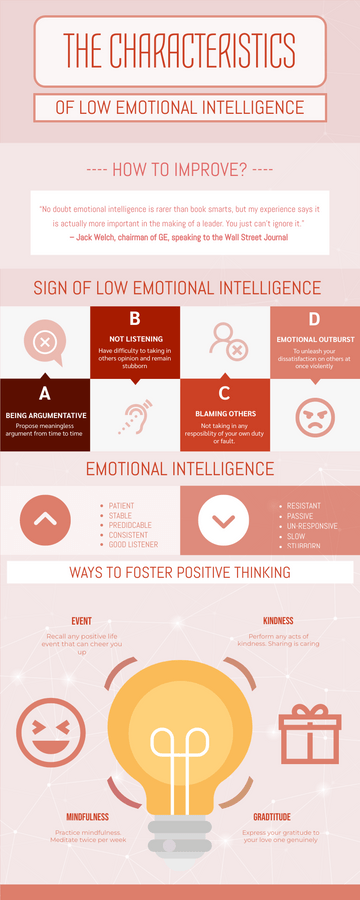The characteristics of low emotional intelligence
Introducing the “The Characteristics of Low Emotional Intelligence” infographic, a comprehensive and visually appealing representation of the essential elements of low emotional intelligence. This infographic has been expertly crafted using Visual Paradigm Online, the ultimate online infographic tool for businesses and organizations seeking to effectively communicate their message to their target audience.
Create Posters that Pop with VP Online’s Advanced Tools
This infographic is specifically designed for organizations looking to raise awareness about the impact of low emotional intelligence on individuals and teams. Its clean, professional design provides a clear and easy-to-follow overview of the key characteristics, making it an ideal educational resource for a wide range of stakeholders.
At Visual Paradigm Online, we believe that the design of an infographic is just as important as the information it conveys. That’s why our online infographic maker is designed to provide businesses with the ability to create high-quality infographics with ease. With a range of customizable templates and a simple, intuitive interface, Visual Paradigm Online makes it easy for businesses to create eye-catching, engaging infographics that communicate their message in a clear and compelling way.
Whether you’re looking to create an infographic from scratch or customize one of our existing templates, Visual Paradigm Online has everything you need to get started. To learn more about our graphic design editor, visit https://online.visual-paradigm.com/infoart/. If you’re looking for inspiration, take a look at our extensive graphic design template library at https://online.visual-paradigm.com/infoart/templates/. Start creating stunning, effective infographics today with Visual Paradigm Online!
Extended Reading: What Are The Characteristics of Low Emotional Intelligence?
Low emotional intelligence can impact a person’s ability to understand and manage their own emotions, as well as the emotions of others. The following are some of the common characteristics of low emotional intelligence:
- Difficulty recognizing and expressing emotions: People with low emotional intelligence may struggle to identify their own emotions, as well as those of others, and may have trouble expressing their emotions in a healthy and appropriate way.
- Impulsiveness: People with low emotional intelligence may act impulsively without considering the consequences of their actions, and may struggle to control their emotional responses.
- Lack of empathy: People with low emotional intelligence may have difficulty understanding the perspectives and emotions of others, and may struggle to show empathy and compassion.
- Poor communication skills: People with low emotional intelligence may struggle with effective communication, and may have difficulty building and maintaining healthy relationships.
- Difficulty managing stress and handling conflict: People with low emotional intelligence may struggle with stress management and may have difficulty resolving conflicts in a healthy and constructive way.
- Difficulty regulating emotions: People with low emotional intelligence may have difficulty controlling their emotions and may react strongly to stressful or challenging situations.
- Inflexibility: People with low emotional intelligence may struggle with change and may have difficulty adapting to new situations or perspectives.
It’s important to note that emotional intelligence can be developed and improved over time, with practice and intentional effort. By working to improve their emotional intelligence, individuals can strengthen their relationships, communication skills, and overall well-being.


